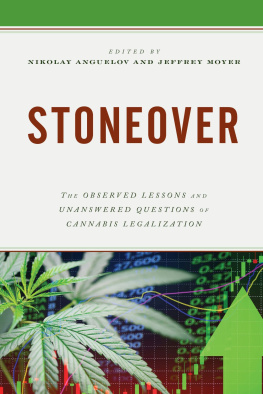THE SCIENCE OF MARIJUANA

Oxford University Press is a department of the University of Oxford. It furthers the Universitys objective of excellence in research, scholarship, and education by publishing worldwide. Oxford is a registered trade mark of Oxford University Press in the UK and certain other countries.
Published in the United States of America by Oxford University Press
198 Madison Avenue, New York, NY 10016, United States of America.
Oxford University Press 2018
First Edition published in 2000
Second Edition published in 2007
All rights reserved. No part of this publication may be reproduced, stored in a retrieval system, or transmitted, in any form or by any means, without the prior permission in writing of Oxford University Press, or as expressly permitted by law, by license, or under terms agreed with the appropriate reproduction rights organization. Inquiries concerning reproduction outside the scope of the above should be sent to the Rights Department, Oxford University Press, at the address above.
You must not circulate this work in any other form and you must impose this same condition on any acquirer.
Library of Congress Cataloging-in-Publication Data
Names: Iversen, Leslie L., author.
Title: The science of marijuana / Les Iversen.
Description: 3rd Edition. | New York : Oxford University Press, [2018] | Revised edition of the authors The science of marijuana, 2008.
Identifiers: LCCN 2018016007 | ISBN 9780190846848 | eISBN 9780190846862
Subjects: LCSH: MarijuanaPhysiological effect. | MarijuanaToxicology.
Classification: LCC QP801.C27 I94 2018 | DDC 615.9/523648dc23
LC record available at https://lccn.loc.gov/2018016007
Contents
Marijuanaknown as cannabis in Europehas been used medically and recreationally for thousands of years. There is a considerable scientific literature on cannabis and the possible beneficial or adverse effects associated with its use. Some societies have regarded cannabis as a sacred boon for mankind that offers respite from the tribulations of everyday life, whereas others have demonized it as inevitably leading to reefer madness. Millions of young people on both sides of the Atlantic are more or less regular users of cannabis, but official attitudes vary widely. In Europe, several countries have relaxed the legal penalties associated with its use. In the United States, several states have sanctioned the medical use of cannabis, and some states have even approved its recreational use; however, these states remain in conflict with the federal government, which continues to view cannabis as an illegal and harmful drug. Cannabis accounted for 643,00 arrests in 2016 in the United States, which were often followed by draconian penalties.
Research on the naturally occurring cannabinoids (endocannabinoids) has grown rapidly since the first edition of this book was published in 2001. Less than 200 scientific papers had been published on these newly discovered chemicals by the time of the first edition. More than 2,000 additional publications appeared by the time of the second edition in 2008, and since then the number of citations in PubMed for endocannabinoids has risen to 5,384, that for THC has risen from 800 to 8,700, and the total number of citations for cannabis in PubMed stands at 16,180. This is clearly an active field of research, and there is an increasing understanding that the naturally occurring cannabinoid system plays many roles in the body apart from acting as modulators of neural activity in the brain. The potential for genuinely new medicines based on our knowledge of the cannabinoids is huge and is only now being exploited:
There is likely no greater hot-button topic in biomedical and clinical research today than discussions surrounding the utility of active chemicals found in marijuana and how they interact within the bodys endocannabinoid system to produce beneficial or deleterious effects. (Gordon Research Conference, Cannabinoid Function in the CNS, 2017; https://www.grc.org/cannabinoid-function-in-the-cns-conference/2017)
Leslie L. Iversen
Professor
Department of Pharmacology
University of Oxford
Oxford, UK
Reviews of the history of cannabis can be found in .
Evidence of the first use of cannabis by humans has been found in fragments of pottery bearing the imprint of a cord-like material thought to be of hemp in Taiwan, dated approximately 10,000 bc. Other early evidence for hemp cultivation derives from the finding of fragments of hemp cloth in Chinese burial chambers from the Chou dynasty (1122265 bc). Hemp is a strain of Cannabis sativa containing little or no psychoactive ingredients, cultivated for its tough fibers. It seems likely that hemp was cultivated and used for the manufacture of ropes, nets, canvas sails, and cloths in ancient China. The first descriptions of the medical and intoxicant properties of the plant are to be found in the ancient Chinese herbal, Pen-tsao, ca. 12 century ad. Classical myth relates that the Chinese deity Shen Nung tested hundreds of herbal materials in a series of heroic experiments in self-medication and agronomics. So potent was this myth of the etiology of medicine that the gods name was attached to the Pen-tsao. This herbal pharmacopeia describes hundreds of drugs, among them cannabis, which was called ma, a pun for chaotic. This ancient text clearly describes the stupefying and hallucinogenic properties of the plant. Pharmacologists and herbalists added sections to the text for many centuries, and Chinese physicians used cumulative editions of Pen-tsao as the standard text on medical drugs for hundreds of years. Shen Nung, the Farmer God, became the patron deity of medicine, with the title Father of Chinese Medicine. Ma, often mixed with wine in a preparation called ma-yao, was used principally for its pain-relieving properties. Although there seems also to have been some use of the drug as an intoxicant in China, this never became widespread.
In contrast to China, the use of cannabis for its psychoactive properties was known by the nomadic tribes of northeastern Asia in Neolithic times, and it may have played an important role in the practice of the religion of shamanism by these people. The nomads brought the plant and its uses to Western Asia and then to India. Ancient Indian legend tells how the Hindu god Siva became angry after a family row and wandered off into the fields by himself. Exhausted by the heat of the sun, he sought shade and refuge under a leafy plant and finally went to sleep. On waking, he became curious about the plant that had given him shelter and ate some of its leaves. This made him feel so refreshed that he adopted it as his favorite food. From then on, Siva was known as the Lord of bhang. In ancient Indian texts, bhang is referred to in the Science of Charmswritten between 2000 and 1400 bcas one of the five kingdoms of herbs... which release us from anxiety. Bhang seems to have been popular with the Indian people from the beginning of history. The gave a detailed picture of how bhang and the more potent cannabis products ganja and charas (the Indian term for cannabis resin) had become incorporated into Indian life and culture.
It took longer for cannabis to reach the West. Hemp was known to the Assyrian civilization both as a fiber plant and as a medicine, and it is referred to as kunnubu or kunnapu in Assyrian documents of approximately 600 bc. The word is probably the basis of the Arabian












